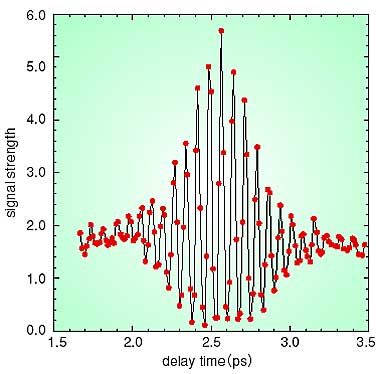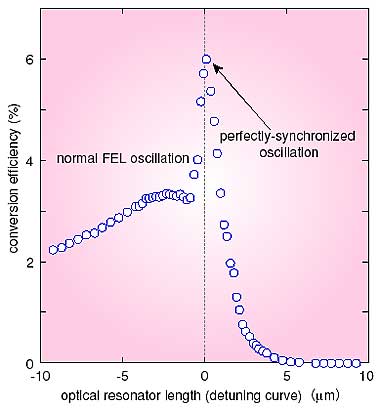In February 2000, the JAERI FEL successfully attained the worlds’ highest
average power (2.34 kW), with a 10 times or larger charge, and 1000 times or longer
pulse than normal FEL electron pulses. Following this success and during the 1999
and 2000 fiscal years, we applied the newly-developed pulse-width measurement
using auto-correlation and the detuning characteristic measurement or external
laser-locking method to measure the optical resonator length shown in the Figs.
8-3 and 8-4, respectively. We confirmed that electron and laser light pulses have
been synchronized perfectly and have formed a few cycles lasing of 255 fs, high
FEL conversion efficiency (6-9%), high peak power (about 1 GW), high average power
(over 2 kW), and wide tunability at the same time in the infrared wavelength region
around 22 micrometer.
The successful achievement of FEL lasing, which is simultaneously wavelength tunable and highly-efficient, and has ultra-short pulses, high average power, and high peak power, was first realized using the super-conducting rf linac-based FEL with a unique long-pulse or continuous-wave operation and high charge pulse acceleration. As a result we discovered the previously unknown, highly-brilliant, and much stronger lasing mode than predicted theoretically. To date, the idea that the average power of a laser is inversely proportional to its peak power is widely accepted. Now there is a strong possibility that an FEL based on the newly-discovered lasing mode will become a powerful FEL with exciting applications as a result of its unique performance of simultaneously producing high average and high peak power lasing that is only available in the new FEL mode. This performance is impossible in any other coherent or incoherent light source.
For example, cutting large reactor containers and pressure vessels quickly without producing radioactive debris may become possible in the near future through the use of high-power FELs with lasing tuned to a fiber-optic-transmittable wavelength. Compact and tunable 100 kW-class FELs are expected to be available in the very near future. They may produce mono-isotopic and novel materials now being developed for nuclear and other industries through large-scale photochemical reactions, and technologies to detect with great sensitively and to decompose or to neutralize environmentally-harmful materials like NOx and PCBs. FEL laser knives for surgery and other medical applications have already been usable and maybe accepted widely in the near future. Because of its superiority in shortening the oscillation wavelength easily in the X-ray region as compared with all other lasers, the new FEL technology will make a great contribution toward a future coherent,
1 angstromX-ray source. Using these new FELs, we can expect to increase the speed
of analyses of three-dimensional structural information of proteins by several
orders of magnitude. This will be extremely significant to a large number of biological
life activities by applying the knowledge gained to produce medicines, medical
diagnostic agents, and other substances and materials. |


